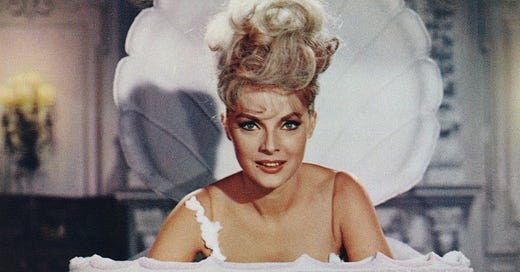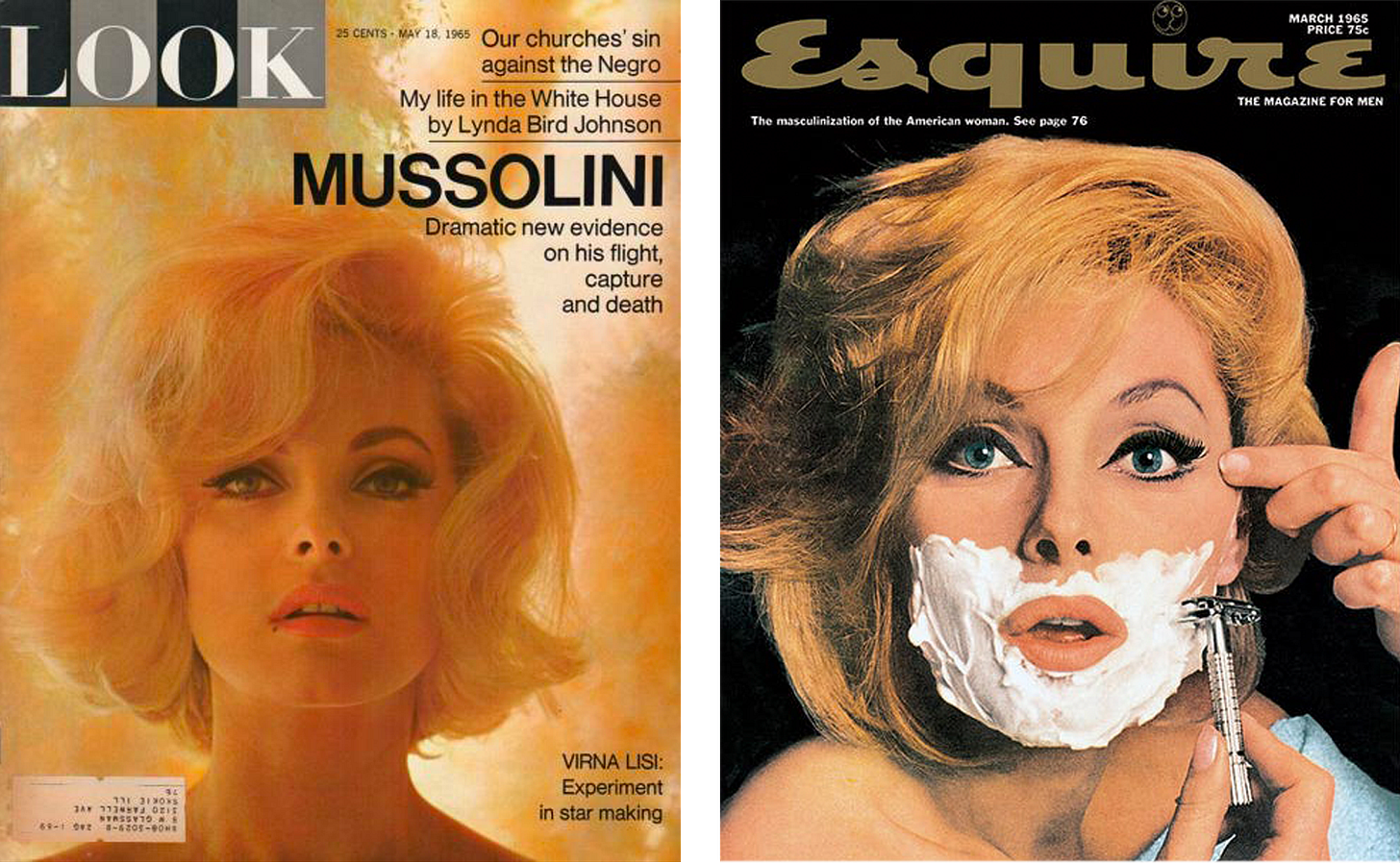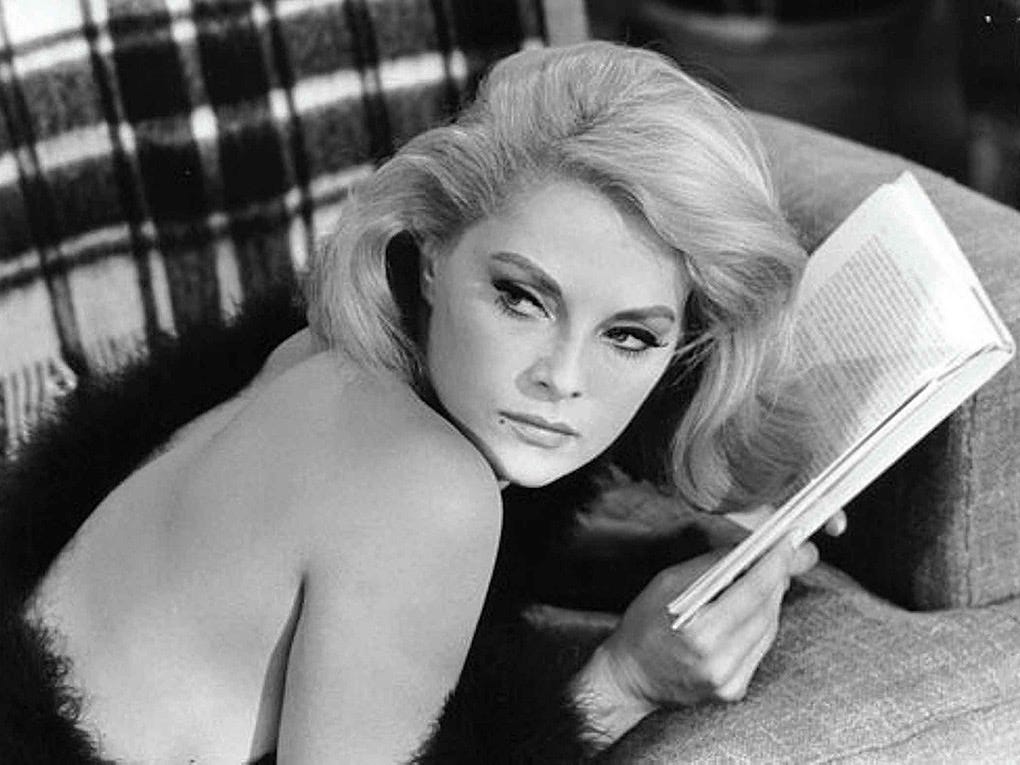In her first American movie, Richard Quine’s How To Murder Your Wife (1965) Virna Lisi emerges from a pink and white stucco wedding cake, reducing a raucous bachelor party to a stunned silence. Small wonder. Green eyed, coral lipped and wearing a bikini apparently made from whipped cream, she is an edible Venus. A dream. And a nightmare to the movie’s hero, confirmed bachelor Jack Lemmon, who wakes up the next morning married to her.
It was an eye-catching debut in madcap, if mysoginistic, farce and George Axelrod, who produced the movie and wrote the script, led the charge in promoting Lisi as ‘the new Marilyn’. Although the writer of Monroe’s first solo hit The Seven Year Itch (1955), Axelrod was missing the point and misjudging the times. When How To Murder Your wife was shot in 1964, a scant two years after Monroe’s death, Hollywood’s collective remorse and guilt did not allow for a ‘new Marilyn’ any more than it could tolerate the rivals it had built in her image, as Jayne Mansfield and Mamie Van Doren – both talented performers – were summarily cut loose, abandoned to exploitation movies, working men’s clubs and dinner theatre, (often reprising roles that Monroe had played on screen).
Blithely ignoring the thirty or so movies Lisi had made over the previous decade, mainly in her native Italy, Axelrod boasted, “I found her, I invented her, I want to make her a household name, like General Motors.”Lisi played along, at least initially. “I don’t mind being nude under a couple of sheets, “ she cooed, MM style, in her fractured English.
She was profiled everywhere: Life Magazine pronounced her ‘like Jean Harlow and Madeleine Carroll put together;’ to Cosmopolitan, she was ‘The most delicious piece of pizza to reach our shores since Sophia Loren;’ Irving Penn photographed her for Vogue. Lisi turned down Playboy, but gamely agreed to wet shave for what would become an iconic and endlessly parodied cover for Esquire, designed by George Lois.
She returned to Italy with an added Hollywood gloss to make Casanova 70 with Mastroianni and Signore & Signore, which shared the Grand Prix prize at Cannes in 1966. In an episode of Le Bambole she lounged around in black feathers chatting to her mother on the phone, to her husband’s annoyance and pent up frustration.
Back in Hollywood to honour her agreement with Axelrod and United Artists, Lisi made two more movies; Not With My Wife You Don’t! a lame sex comedy and Assault On A Queen, a heist adventure in which she and Frank Sinatra generated little chemistry. Dino De Laurentiis offered her Barbarella, but she wasn’t interested. “They said you would look wonderful with wings and long silver hair. I said that I wanted to play something, a real part,” she commented, ceding the role to Jane Fonda. After that, despite Axelrod’s warning that you are “not a star until you are a star in America”, she bought back her contract and returned permanently to Europe.
She was born Virna Pierlisi in Ancona on the Adriatic coast in 1936. At 17, she moved to Rome to study but was persuaded to do a screen test by a family friend. She made her debut in 1953 and over the next two years featured in more than a dozen comedies, musicals and melodramas. Attractive, attentive and dark haired, Lisi was versatile but seldom dominated a film. Nevertheless, by the late 1950s, she was a household name in Italy, in part due to a series of toothpaste commercials with the tag line “With a mouth like that, she can say anything she wants.”
Her marriage to architect and property mogul Franco Pesci in 1960 was front-page news, as was the birth of their son, Corrado two years later. Reporters were shown around their villa in the Alban hills and duly noted Lisi’s 12 fur coats, fleet of sports cars and her pilot’s license
She starred in a peplum Romolo e Remo (1961), wearing a toga as short as censors would allow and had a supporting role in Joseph Losey’s turbulent Eva (1961) a vehicle for Jeanne Moreau. She was Delon’s love interest in the swashbuckling La Tulipe Noir, (1963) a big box office success in France, but passed on the chance to be a Bond girl in From Russia With Love (1963), before Axelrod ‘found’ her in Paris and put her under contract.
Back in Rome after her Hollywood interlude, Lisi starred in a string of movies including Le Dolce Signore (1967) a dressy sex comedy with Ursula Andress, Claudine Auger and Marisa Mell; and The Secret of Santa Vittoria (1969) in which she provided a welcome respite from the full blown histrionics of Anna Magnani and Antony Quinn. No one could save the execrable Bluebeard (1972). Richard Burton took the title role and Lisi was one of the many wives he dispenses with (she is guillotined because she won’t stop singing).
Lisi talked of retirement, but the offers were too good: She played Nietzsche’s neurotic sister in Beyond Good And Evil (1977) directed by Liliana Cavani for which she won the Silver ribbon award as Best Supporting Actress. In La Cicala (1980) she was cast against type as a blowsy former singer drawn into prostitution, and for that took the David di Donatello Best Actress prize. There would be another Best Actress Silver Ribbon for Buon Natale…Buon anno, (1989) one of Luigi Comencini’s last movies, in which she and Michel Serrault rekindle an old love.
Lisi’s full-blown career renaissance came with Patrice Chéreau’s, La Reine Margo (1994). As the manipulative Catherine de Medici, Lisi played against her looks. She admitted it was a problem for many to see beyond the beauty, but with her raised hairline, darkly malevolent eyes and perfect bow mouth now corrupt. Lisi was a revelation. She won a César award and Best Actress at Cannes, crying ‘like a starlet’ when she reached the podium, acknowledging that the accolade had taken 35 years.
Lisi, who lived in high style on the Via Salaria in Rome, worked steadily thereafter in films and on TV. She remained married to Pesci who predeceased her by a year, and her own funeral in 2015 drew crowds. La Lisi was a lady.
The Essential Virna Lisi
Romolo e Remo (1961), director Sergio Corbucci
Eva (1962) director Joseph Losey
La Tulipe Noir (1964), director Christian-Jaque
How To Murder Your Wife (1965), director Richard Quine
Casanova 70 (1965), director Mario Monicelli
The Secret of Santa Vittoria (1969), director Stanley Kramer
Beyond Good and Evil (1977), director Liliana Cavani
La Reine Margot (1994), director Patrice Chéreau,











